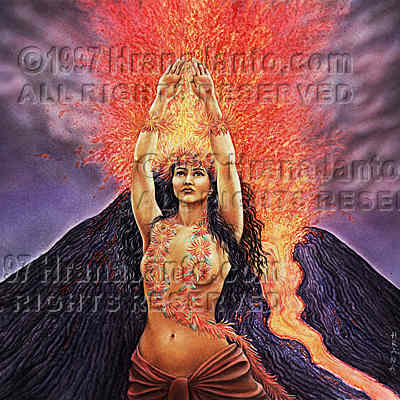 |
|
|||||
PREVIOUS | NEXT | A,B,C, D,E, F,G,H,I, J,K,L,M, N,O,P,Q, R,S, T,U,V,W,X,Y,Z | Help | ALL | INDEX
| Pele from Goddesses and Heroines |
Exerpt from Goddess & Heroines by Patricia
Monaghan [Used by permission. This text is NOT included in the Goddess Oracle] |
Of all the world's goddesses, Pele is one of the few still living in the belief of her people, not as metaphor but as metaphysical reality, to whom offerings are still made when volcanic eruptions threaten Hawaiian towns.
A bright daughter of the earth goddess Haumea, Pele spent her girlhood watching fires and learning how to make them, thus revealing her temperament early. This did not please the sea goddess Namaka,who prophesied an unpleasant future for the fire-loving girl, but she, who lived in the ocean, may have been biased. But Namaka had a point: Pele did cause a conflagration in her mother's homeland once, toying with underworld fires.
The mother, knowing that Namaka would persecute Pele on her return, suggested that it was time for Pele to find a home of her own. So she set off in a canoe with several siblings including her sister Hiiaka ("cloudy one"). They were malihini, goddesses who migrated to Hawaii after human settlement there began. Hawaii was only an atoll when they arrived, so Pele used a divining rod to locate likely places to build islands, then caused them to be born in tempestuous eruptions from undersea volcanoes.
Namaka trailed her sister, furious at the destruction Pele had wrought in their original homeland. Ocean and fire met in a terrific brawl, and Pele got the worst of it, rising like a steamy spirit from the fray. No longer embodied, she disappeared into the Hawaiian volcanoes, especially in the fiery part of the crater of Kilauea called Halemaumau, said today to be one of her favorite haunts.
There she was honored by the Hawaiian people as the essence of earthly fire. Into her craters, offerings were cast: cut hair, sugar cane and flowers (especialy hibiscus), white birds, money and strawberries. Some say that human beings were also tossed into the lava; others deny this, claiming there is no evidence for such rites.
There is one famous legend, however, that suggests that some were, if not sacrificed literally, at least consecrated to the goddess. This is the tale of the young Hawaiian man named Lohiau. Pele, it was said, sometimes dozed in her crater, sending her spirit wandering through the islands. One night, hearing the sweet melodies of flutes, she followed the sound until she came upon a group of sacred hula dancers.
Among them was Lohiau. Instantly attracted to him, Pele embodied herself in beautiful human flesh and seduced him. They spent three days making love before she decided that it was time to return to her mountain. Promising to send for him, Pele disappeared, awakening far away on Kilauea.
Not one to break a promise--and immediately desiring the young man again--Pele endowed her sister Hiiaka with magic and sent her off to fetch Lohiau. Hiiaka was a kindly goddess, given to singing with the poet goddess Hopoe and to picking blossoms from the tropical trees. But out of dedication to her sister, Hiiaka set off, first making Pele promise to tend her gardens.
Passing through many trials, often relying on her magic to defeat threatening monsters, Hiiaka reached Lohiau's home just as he died, pining away for his lover Pele. But Hiiaka caught his soul and pushed it back into his body, reviving him. Then they set off for Kilauea.
Although touched by the man's beauty, Hiiaka fully intended to furfill her task and bring Lohiau untouched to her sister. But Pele was a jealous spirit, and she soon began to burn, imagining Hiiaka in Lohiau's arms. The crater began to spit out lava fretfully. Pele was growing angry.
Hiiaka understood the messages from the distant crater and hastened along. Even though challenged for possession of the man by a sorceress (probably Pele in disguise) and even though Lohinu told Hiiaka he loved her more than Pele, the goddess would not betray her sister's trust. All the way to the crater she conveyed the prize, only to find that Pele had not kept her part of the promise, that the volcano goddess had in jealous fury killed the poet Hopoe and scorched Hiiaka's lovely gardens.
Right then and there, on the rim of the crater, Hiiaka made love to Lohiau. Pele, erupting in fury, burned the man to death but could not destroy her immortal sister. Hiiaka, not about to lose to her angry sister, descended to the underworld to free Lohiou's soul. When she arrived at the deepest circle of the underworld, the point at which the rivers of chaos were held back by a gate, it occurred to her that flooding the entire world would thoroughly extinguish Pele and her wrath.
Her conscience kept her from such folly, however. Hiiaka, after freeing Lohiau's soul, determined to return to the surface and demand her lover from Pele. The lustful, angry goddess would not have been willing, except that Lohiau's comrade Paoa arrived in timely fashion to satisfy the goddess's heat. Hiiaka was reunited with Lohiau, and they retired to his country. Pele, meanwhile, found herself a lover of sturdier stuff in the combative hog god Kamapua'a, inventor of agriculture, whose idea of courting a goddess included all but dousing her flames with heavy rain and stampeding pigs across her craters. To this day, their turbulent affair continues on the islands called Hawaii.
| Back to TOP | Published by Llewellyn, copyright 1997. Used by permission of the author. |
![]()